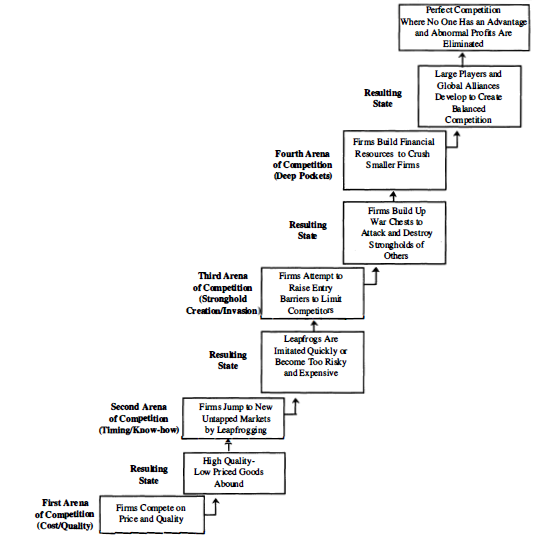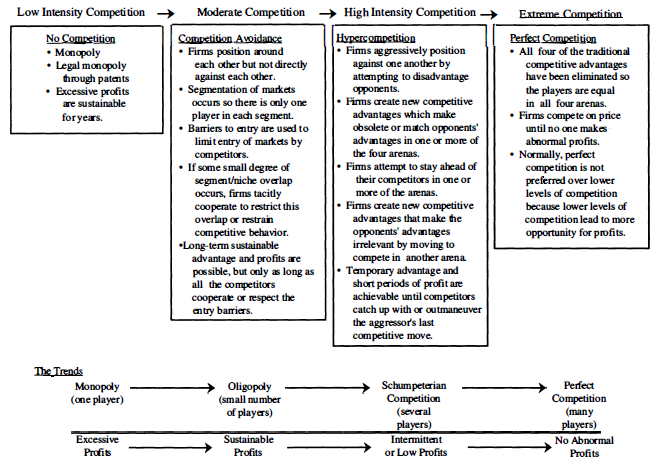1. Two Types of Escalation
Research of the trajectories within each arena of competition reveals two types of escalation. The first is the escalation within each arena. As outlined in the discussion of trends in each arena, moves lead to countermoves, and the competition continues to escalate. Firms move to higher and higher levels of conflict in each arena, as if they are escalating up a ladder with each rung representing the new level of competition introduced by the last competitive maneuver. So, for example, firms escalate by increasing the level of quality or lowering the price of their goods. They also escalate their efforts to develop new know-how, move faster, invade or create new strongholds, and build deep pockets. Part I of the book will examine this process of escalation in each of the four arenas. It will look at the strategic insights provided by each of the four static views of competitive advantage, and it will consider the implications of a long-term dynamic view of the moves and countermoves that are typically observed.
There is a second type of escalation going on as well. As described above, escalation occurs across arenas, as illustrated in Figure 1-4. Companies may begin competing on cost and quality until they exhaust the advantages of that arena. They then move on to know-how in the second arena until the benefits of these advantages are too expensive. They then attempt to create strongholds to limit the competition, but these strongholds are eventually breached. This leads to the use of deep pockets, wherein size is an advantage until firms deplete their resources or find alliances to balance off the resources of competing alliances. As discussed below, this is only one possible scenario for movement across arenas.

FIGUREI-4
ONE SCENARIO FOR THE ESCALATION OF CONFLICT ACROSS
ARENAS OF COMPETITION
Jumps across arenas can also be much less orderly, moving back and forth into arenas that offer the best possible opportunities for creating new advantages and seizing the initiative.
Figure 1-4 points out that the evolution of an industry makes it increasingly harder to gain and maintain strategic advantage. As firms reach the top of the figure, they approach a “perfectly competitive” market. Every firm must offer low price and high quality, so no one has the advantage. Imitation happens so rapidly that everyone offers almost the same product line, and no one has a serious first mover advantage. Firms compete to develop know-how that competitors don’t have, but they find that know how (as well as products) can be imitated. Global competition has eroded traditional strongholds, so eventually no one has the advantage of a well- protected safe haven. Finally, the deep-pocket advantage is eroded through global alliances and joint ventures until resources are no longer unequal. Firms move up the ladders one step at a time, arriving at a place where no competitor ever intended to go and no one has an advantage.
Although, for convenience, this flow is described as a sequential process, it is often much less orderly than this description would suggest. Some industries follow these patterns fairly closely, but some compete in multiple arenas and at different levels of each arena simultaneously. Some industries get stuck at one level of an escalation ladder for years, and others skip right over that level, depending upon the aggressiveness of competitors in each industry. Thus, in the real environment there is significantly more complexity. The more simplified description here is designed to emphasize relationships within and among the arenas and to stress the broader trends in competition based on these four traditional sources of competitive advantage. This is done for the sake of clarity, not to suggest that the real progression toward a perfectly competitive environment is anywhere near this predictable.
2. Hypercompetition: Movement toward, but Failure to Reach, Perfect Competition
As illustrated in Figure 1-4, competition escalates in and across these four arenas, moving from a state of relatively less competition to a state of perfect competition wherein no player has an advantage in any of the four arenas and all firms compete on price until no one makes any profits. What this points out is that different grades or levels of competition exist in an industry over time. Figure I-5 illustrates the various levels that industries may go through.
American corporations have traditionally sought established markets wherein sustainable profits were attainable. They have done so by looking for low or moderate levels of competition. Low and moderate-intensity competition occurs if a company has a monopoly (or quasi monopoly protected by entry barriers) or if competitors implicitly or explicitly collude, allowing each other to “sustain” an advantage in one or more industries or market segments. Collusion or cooperation, while it can be useful in limiting aggressiveness, is limited because there is incentive to cheat on the collusive agreement. An aggressive player can escalate up one or more of the escalation ladders in the four arenas and gain advantage. Entry and mobility barriers are destroyed by firms seeking the profit potential of industries or segments with low or moderate levels of competition. Gentlemanly agreements to stay out of each other’s turf fall apart as firms learn how to break the barriers inexpensively.

AGUREI-5
DIFFERENT LEVELS OF COMPETITION WITHIN AN INDUSTRY
As competition shifts toward higher intensity, companies begin to develop new advantages rapidly and attempt to destroy competitors’ advantages. This leads to a further escalation of competition into hypercompetition, at which stage companies actively work to string together a series of temporary moves that undermine competitors in an endless cycle of jockeying for position. Just one hypercompetitive player (often from abroad) is enough to trigger this cycle.
No matter what pattern competitors follow through the escalation ladders, it is the speed and intensity of the movement that characterizes hypercompetition. At each point firms press forward to gain new advantages or tear down those of their rivals. This movement, however, takes the industry to faster and more intense levels of competition. The most interesting aspect of this movement is that, as firms maneuver and outma- neuver each other, they attempt to neutralize each other’s advantage in all four arenas. This means that they are constantly pushing toward perfect competition, where no one has an advantage. However, while firms push toward perfect competition, they must attempt to avoid it because profits are not at all possible in perfectly competitive markets. In hypercompeth tive markets it is possible to make temporary profits. Thus, even though perfect competition is treated as the “equilibrium” state in static economic models, it is neither a desired state nor a sustainable state from the perspective of corporations seeking profits. They would prefer low and moderate levels of competition but often settle for hypercompetitive markets because the presence of a small number of aggressive foreign corporations won’t cooperate enough to allow the old, more genteel levels of competition that existed in the past; for example, the old nonaggressive competition among the Big Four U.S. car companies and planned obsolescences that existed before foreign competitors entered the U.S. market. Part II examines the nature of environments in more detail and how hypercompetition develops when the companies involved often do not desire it.
In one sense, it might seem that hypercompetition is just a faster version of traditional low- and moderate-intensity patterns of competition, but that is like saying that a hurricane is a faster form of summer breeze. The key strategies for survival and success are different. Low- and moderate-intensity competition, which is relatively static for long periods of time, is characterized by long periods of advantage disrupted infrequently by breakthroughs or actions that erode that advantage. Hypercompetition, on the other hand, is characterized by short periods of advantage punctu, ated by frequent disruptions. The focus thus shifts from managing advan, tages to effectively managing disruption.
Source: D’aveni Richard A. (1994), Hypercompetition, Free Press.
